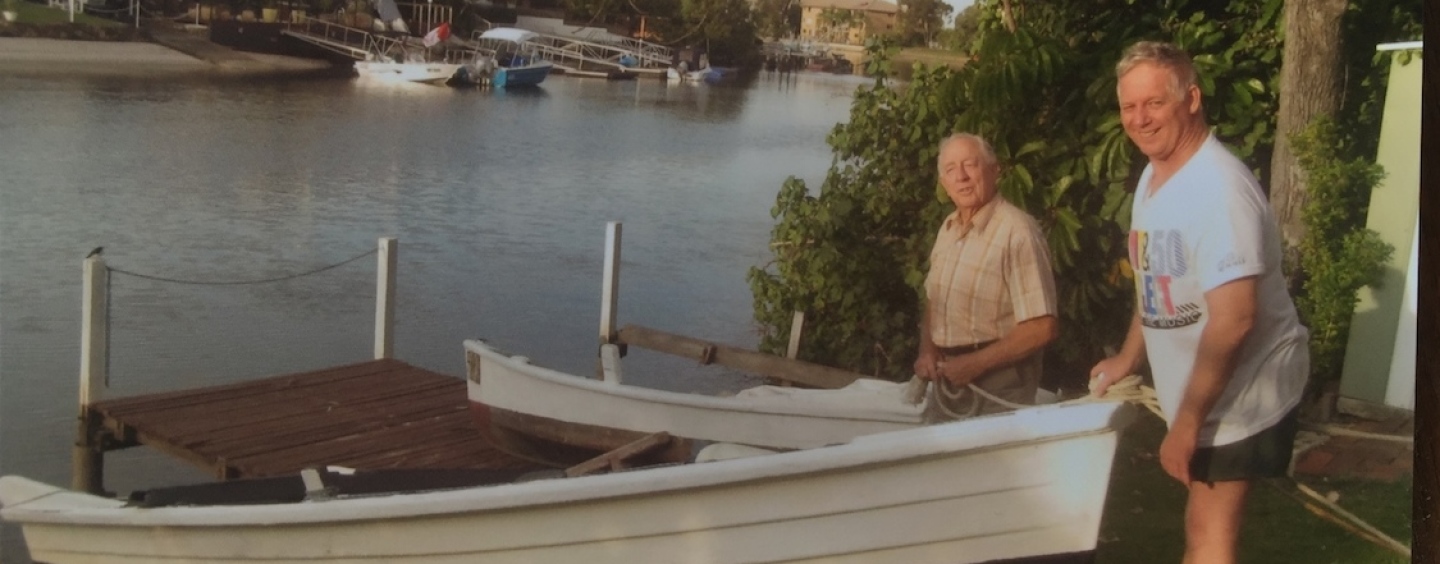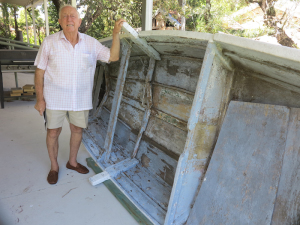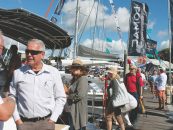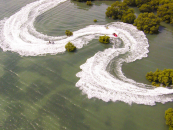“Sometime between the late 1960’s and early 1970’s, an old wooden boat washed up on the ocean beach shores of South Stradbroke Island. The boat was found by one of the members of the Hage family, a pioneering Southport fishing family.” So the story goes, according to Denis O’Connell who recalls the mysterious urban legend.
Denis further says that Brian Hage passed the boat onto fisherman Jeff Medland who eventually gave the boat to Denis and his son, Greg, another of the Gold Coast pioneering fishing families.
Denis, a former mayor of the Gold Coast, is the steward of Gold Coast’s most intriguing pieces of local nautical history. The “mystery” boat is one of them. He describes the coincidental arrival of the boat to the small fishing community as being “handy”.
The mystery boat, dubbed as “surf boat” was believed to have been built during 1930-40’s by a craftsman from the NSW Northern Rivers region. The boat builder must have had an advanced understanding of surf boat building, as the boat did not easily broach in the surf when catching a wave. The boat was only 12 feet long.
While reminiscing, Denis says, “The unique hull design was ideally suited for surf conditions, as well as calm waters such as the Broadwater. So the boat was put to good use as a net boat. It was fitted with two sets of oars: one person standing to row with nine-foot oars while facing the bow, and another person rowing with eight-foot oars sat facing the stern.”
The surf boat was mainly used for mullet fishing. Back in those days, the local fishing families, such as the Dux, Wild, Hallindale, Kings, Isgro, McNalie and Tuesley families, to name a few, were known as the “Southport crew”. Traditionally, they fished for sea mullet in the winter months. From April to August, the mullet leave the rivers and canals of the Gold Coast and make their way out to the ocean beaches to spawn, joining the sea mullet travelling from the south up the east coast.
Denis describes how the surf boat was maneuvered to catch the mullet. “Guided by the standing oarsman and loaded with approximately 180 metres of fishing nets, the boat would head out through the surf, travelling in an arc around the school and back to shore. Laying the net around the school of fish, referred to as ‘shooting the net’, was done by both oarsmen rowing in unison. As the boat caught each set of waves, the seated front oarsman would take command to safely return to shore.”
Denis says that if executed successfully, the two brave occupants will prevent the boat from swamping or capsizing, and the mighty hauls would be “landed up” on the beach.
An in-depth understanding of the movements and habits of the spawning mullet meant that the fisherman could predict when the mullet would leave the rivers and run towards the ocean beaches, by observing the weather conditions. The crews would launch at the command of a man on the beach, “the spotter”, who would confirm when the fish were on the way. “In those days, you needed a lot of skill with the oars,” relates Denis.
Over the years, this small surf boat that mysteriously washed up on the shores of South Stradbroke was used to catch mega-tonnes of fish and became an important part of local fishing history. Proving details of the fishing procedures in the Gold Coast at this time, Denis recalls, “These large hauls of fish were transported back to the mainland and delivered to the Fish Board in Southport and were sold at auction, along with the prawns caught by local trawlers.”
When not used to capture the sea mullet along the ocean beaches due to poor weather conditions, the boat was used in a similar way inside the Broadwater, as schools of mullet would sometimes travel inshore, along the western shores of South Stradbroke.
Denis and Greg owned a similar slightly larger 16-foot net boat which was used for fishing in the Broadwater. With both boats working, they were capable of hauling tonnes of fish for the Southport fishing crew from 1973 to the 2000’s.
The original “surf boat” was eventually donated by the O’Connell’s to the Gold Coast and Hinterland Historical Museum at 8 Elliott St, Surfers Paradise and is open to the public Sundays 10am-3pm, Admission is $5.00.
———-
Denis O’Connell was mayor of the Gold Coast City Council from 1982 to 1985, and was a councilor for nine years. Along with his many life achievements and contributions to the local community, he is also acknowledged as a life member of the Queensland Seafood Industry Association (QSIA), and has previously sat on the Gold Coast Harbour Board, the Gold Coast Waterways Authority and the Great Barrier Tourist Committee.
By Andy Kancachian































